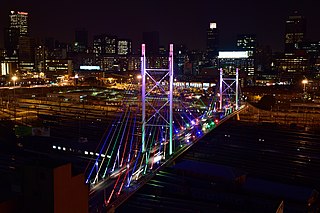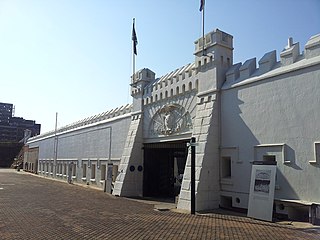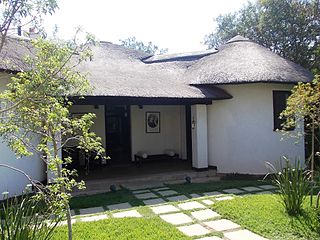
Gandhi Square (formerly Van Der Bijl Square and Government Square) is a plaza located in the Central Business District of Johannesburg, South Africa. It is named after the political activist and pacifist, Mahatma Gandhi.

Gandhi Square (formerly Van Der Bijl Square and Government Square) is a plaza located in the Central Business District of Johannesburg, South Africa. It is named after the political activist and pacifist, Mahatma Gandhi.

In 1900 on what was then called Government Square near the Court House, on 31 May Field Marshal Roberts accepted the surrender of the city from Z.A.R. Commandant, Dr. F.E.T. Krause. [1] Judge Krause had been put in command of the city and had earlier prevented the dynamiting of the goldmines. [2] The British allowed them a day to evacuate Johannesburg provided they did not set off the mines. [1]
The square is just off Rissik Street and it was a corner of Rissik and Anderson that Mahatma Gandhi once had his legal offices. A statue of Gandhi was erected in the square in October 2003. [3]
Before it was named Gandhi Square, Van Der Bijl square was falling apart. It was in the centre of one of Johannesburg's most destitute neighbourhoods. Then, in the early 1990s, Gerald Olitzki, a property developer, approached the government with the project. Although initially denied, the project was eventually undertaken with the support of the government, and was finished in 2002, [4] at a cost of approximately R2 million. The local bus terminal has also been renovated, as there is now 24-hour security, and many of the shops along the square have returned.

Mohandas Karamchand Gandhi was an Indian lawyer, anti-colonial nationalist and political ethicist who employed nonviolent resistance to lead the successful campaign for India's independence from British rule. He inspired movements for civil rights and freedom across the world. The honorific Mahātmā, first applied to him in South Africa in 1914, is now used throughout the world.

Johannesburg is the most populous city in South Africa with 4,803,262 people, and is classified as a megacity; it is one of the 100 largest urban areas in the world. It is the provincial capital and largest city of Gauteng, which is the wealthiest province in South Africa. Johannesburg is the seat of the Constitutional Court, the highest court in South Africa. Most of the major South African companies and banks have their head offices in Johannesburg. The city is located within the mineral-rich Witwatersrand hills, the epicentre of the international-scale mineral, gold and (specifically) diamond trade.

Ladysmith is a city in the Uthukela District of KwaZulu-Natal, South Africa. It lies 230 kilometres (140 mi) north-west of Durban and 365 kilometres (227 mi) south-east of Johannesburg. Important industries in the area include food processing, textiles, and tyre production. Ladysmith is the seat for both the Alfred Duma Local Municipality and Uthukela District Municipality.

Johannesburg is a large city in Gauteng Province of South Africa. It was established as a small village controlled by a Health Committee in 1886 with the discovery of an outcrop of a gold reef on the farm Langlaagte. The population of the city grew rapidly, becoming a municipality in 1898. In 1928 it became a city making Johannesburg the largest city in South Africa. In 2002 it joined ten other municipalities to form the City of Johannesburg Metropolitan Municipality. Today, it is a centre for learning and entertainment for all of South Africa. It is also the capital city of Gauteng.

Fatima Meer was a South African writer, academic, screenwriter, and prominent anti-apartheid activist.

Manilal Mohandas Gandhi was the second son of Mahatma Gandhi and Kasturba Gandhi.

Vanderbijlpark is an industrial city with approximately 95,000 inhabitants, situated on the Vaal River in the south of Gauteng province, South Africa. The city is named after Hendrik van der Bijl, an electrical engineer and industrialist.
International cricket in South Africa between 1971 and 1981 consisted of four private tours arranged by English sports promoter Derrick Robins, two tours by a private team called the "International Wanderers", and one women's Test match. The apartheid policy followed by the South African Governments of the day meant that no Test match playing nation was willing to tour, thereby depriving world cricket of leading stars such as Graeme Pollock, Barry Richards, Clive Rice and Eddie Barlow.

The Constitution Hill precinct is located at 11 Kotze Street in Braamfontein, Johannesburg near the western end of the suburb of Hillbrow. Constitution Hill is the seat of the Constitutional Court of South Africa.
Chinese South Africans are Overseas Chinese who reside in South Africa, including those whose ancestors came to South Africa in the early 20th century until Chinese immigration was banned under the Chinese Exclusion Act of 1904. Chinese industrialists from the Republic of China (Taiwan) who arrived in the 1970s, 1980s and early 1990s, and post-apartheid immigrants to South Africa now outnumber locally-born Chinese South Africans.
The following lists events that happened during 1956 in South Africa.
Troyeville is a suburb of Johannesburg, South Africa. It is a small suburb found on the eastern edge of the Johannesburg CBD, with the suburbs of New Doornfontein, Bertrams and Lorentzville to the north, Fairview to the south and Kensington to its east. The main road through the suburb is Albertina Sisulu Road, which connects the CBD to Johannesburg's eastern suburbs and towns of the East Rand. It is located in Region F of the City of Johannesburg Metropolitan Municipality.

Thillaiyadi Valliammai was a South African Tamil girl who worked with Mahatma Gandhi in her early years when she developed her nonviolent methods in South Africa fighting its apartheid regime.
Pieter Gerhard Vintcent van der Bijl was a South African cricketer who played in 5 Tests in 1938–39. His son, Vintcent, also had a successful first-class cricket career.

Hermann Kallenbach was a Lithuanian-born Jewish South African architect who was one of the foremost friends and associates of Mahatma Gandhi. Kallenbach was introduced to the young Mohandas Gandhi while they were both working in South Africa and, after a series of discussions, they developed a long-lasting association.

Johannesburg Park Station is the central railway station in the city of Johannesburg, South Africa, and the largest railway station in Africa. It is located between the Central Business District and Braamfontein, in the block bordered by Rissik, Wolmarans, Wanderers, and Noord Streets. Park Station lies on the main Witwatersrand railway line that runs East-West from Krugersdorp to Germiston. The first four stations to the east are Doornfontein, Ellis Park, Jeppe and George Goch Stations.

Satyagraha House, commonly known as Gandhi House, is a museum and guest house located in Johannesburg. The house belonged to Mahatma Gandhi: he lived and worked there between 1908 and 1909. It is registered as part of Johannesburg's historical heritage. Satyagraha means insistence on truth. The house was designed by the architect Hermann Kallenbach for Gandhi and himself.

Johannesburg City Hall is an Edwardian building constructed in 1914 by the Hawkey and McKinley construction company. The plan for the building was drawn in 1910 and construction was started in 1913 and finished in 1914. The Gauteng Provincial Legislature currently occupies the building. The City Hall has seen many political events on its steps from protest meetings to a bomb blast in 1988.
M. K. Gandhi is a bronze statue of Mahatma Gandhi in Gandhi Square, Johannesburg, which depicts the Indian independence campaigner and nonviolent pacifist as a young man.